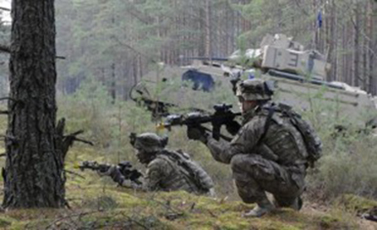
The Not-So-Grand Strategy Behind America’s Warring Around
By F. William Engdahl
26 April 2017
It’s getting pretty crazy, the warring around of Washington since the Trump Project took office January 20. The question is whether there is a true strategy behind the dramatic escalation of Trump Administration military aggression around the world. There definitely is in my view, and it’s not good for world peace, not good for the United States and the rest of the world .
First, just a week into office, the new President authorized a Navy Seal illegal attack in Yemen’s civil war in which one Seal was killed and four wounded, allegedly intervening to hit the Al Qaeda in Yemen terrorist organization, yet another spin-off of the CIA’s Afghan Mujahideen. Then on April 7, a Syrian false flag sarin bomb allegation, with no independent international verification, was used by Washington as excuse for the US Navy to launch 59 US Tomahawk missiles to try to destroy a key airbase of the legitimate government of Syria. Videos, most faked, showing dead or suffering children was the offered pretext as well as the alleged disgust of Ivanka Trump, the President’s alarmingly influential daughter.
Before the world could even take stock of what Washington was doing in Syria, the illegal –according to the UN Charter which USA is a signatory to– Syria attacks were followed on April 13 with an equally illegal bomb attack on Afghanistan, which according to former President Karzai killed innocent civilians. There, seemingly out of the blue, just for good measure lest the world think a President Trump is a pussy as in slang for coward, the US President approved dropping of something called MOAB, or GBU-43/B Massive Ordnance Air Blast Bomb (MOAB)- in military speak, Mother of All Bombs–the largest non-nuclear bomb in the US arsenal, allegedly killing 90 ISIS terrorists in caves, hardly a game-changer.
That in turn has been followed by the April 14 announcement of Washington’s Africa Command (AFRICOM) sending troops of the US 101st Airborne Division into the oil-rich geopolitically strategic Horn of Africa state of Somalia, the first US “boots on the ground” in Somalia since the ill-fated 1993 Battle of Mogudishu that inspired little more than a Hollywood movie, Blackhawk Down. The Somalia pretext is to eradicate the Saudi-financed al Shabaab Wahhabite terrorist organization.
Now the US President is saber-rattling using North Korea and its mentally-unstable 33-year-old dictator, Kim Jong-Un, and his missile threats as pretext, sending the ships of the Seventh Fleet to the Korean Peninsula and tweeting threats of USA striking pre-emptively with conventional weapons against North Korea if China doesn’t get her rogue neighbor “under control.”
Fundamental Heartland Geopolitics
These alarming incidents of a US show of force, or the appearance of same, are by no means random. It’s all at the heart of fundamental US geopolitical strategy since 1945. All, including the decision by the US patriarchs to bring something called the Trump Project to Washington, is part of a not-so-grand Anglo-American strategy of world domination. As a reaction to increasingly aggressive and economically painful policies of Washington since the US-triggered global financial crisis of 2008, China, Russia and a host of other nations including most of Eurasia and the countries of the BRICS, have begun to work seriously to create an alternative to the US dollar system that is destroying their economic stability.
As a reaction to the blatant US coup d’ etat in Ukraine in February 2014, designed to drive a huge wedge between Russia and the EU, notably Germany and German industry, Russia began to turn to her east, especially to growing economic and military cooperation with China.
For her part, the Chinese President, Xi Jinping, responded by inviting Russia and the Russian-led Eurasian Economic Union—an emerging five nation economics union of Russia, Belarus, Kazakhstan, Armenia and Kyrgyzstan as an integrated single market of 183 million people and a gross domestic product of over 4 trillion US dollars—to join China’s mammoth One Belt, One Road (OBOR) ports and high-speed rail infrastructure project. China’s OBOR at present spans all Eurasia land space and beyond to Western Europe and to Iran and potentially other Persian Gulf oil states, to Egypt and perhaps to Turkey. That multi-trillion dollar economic network is transforming the economic center-of-gravity of the world to Eurasia. Additionally, it is creating a natural alternative to the dollar in form of national gold-backed currencies as China and Russia build up their central bank gold reserves.
Under the Obama Presidency, the US and its patriarchs and their geopolitical strategists such as Rockefeller-adviser Henry Kissinger, realized that they were in danger of losing everything, losing world hegemony. The badly-bungled US wars in the oil-and-gas-rich Middle East since 2003 and especially the bold Russian acceptance of Bashar al-Assad’s request for military support against US-trained ISIS and Al Nusra terrorists signaled the twilight of American global power and influence were deeply disturbing the American quest for control of world oil and gas. Washington was becoming viewed in the words of the late Mao as a “paper tiger.”
Even the President of the small former US colony, the Philippines, Rodrigo Duterte, was openly defying Washington in his colorful way, and negotiating an alliance with China and Russia and a “separation” from Washington by late 2016. Another pivotal state from the standpoint of Eurasian geopolitical control, Turkey, was also shifting out of the US orbit towards rapprochement with Russia, especially following a failed July, 2016 CIA coup attempt using the Turkish networks of their CIA asset, Fethullah Gülen. The states of the EU were increasingly getting fed up with Washington-ordered economic sanctions against the Russian Federation.
Who controls the Heartland…
To understand the strategy that links the various military actions in the first days of the Trump presidency it’s only necessary to grasp the essential axioms of Anglo-American geopolitics as formulated by the grand master of British geopolitics, Sir Halford Mackinder, nearly a century ago at the Versailles “peace” talks following defeat of Germany after World War I.
n his 1919 book, Democratic Ideals and Reality, Mackinder in three brief sentences reveals the essence of British and after 1945, of American foreign policy. Mackinder wrote:
- Who rules East Europe commands the Heartland;
- Who rules the Heartland commands the World-Island;
- Who rules the World-Island controls the world.
For Mackinder, the Heartland was the Eurasian expanse of Russia and China and surrounding states. East Europe included Germany, Poland, France, Hungary, Czechoslovakia, Austria. The World-Island was the vast expanse from Continental Europe across Eurasia and down to the oil-rich Middle East.
Mackinder’s last geopolitical essay before his death was on the invitation of the Rockefeller-dominated Council on Foreign Relations, the sister foreign policy think-tank of the London Royal Institute of International Affairs or Chatham House. His essay, published in the CFR’s July 1943 issue of Foreign Affairs was titled “The Round World and the Winning of the Peace.” In the essay, foreseeing that the United States would displace the British Empire after the world as the global hegemon, Mackinder anticipated the emergence of both Russia- then the Soviet Union spanning Eurasia–and of China, and possibly India, as vast Eurasian land powers. As well Mackinder saw the rise of the Anglo-American states of the Atlantic as what became several years later NATO, the North Atlantic Treaty Organization. Both Henry Kissinger and Zbigniew Brzezinski are disciples of the Mackinder British Geopolitics of the Heartland. The current Trump military and foreign policy, as I have written elsewhere, involves a shift in tactic but none in the basic US Grand Strategy of geopolitical control of Eurasia.
Initially, the Trump plan was to woo the “weaker” of two fundamental geopolitical Eurasian adversaries, Putin’s Russian Federation, in hopes of convincing a sanctions-weakened Russia to abandon its support of Syria and de facto cooperation with Iran and with China. Had that succeeded it would have been “checkmate” for Eurasia as an alternative.
As I’ve noted before, Russia’s leaders are many things but stupid is not one in terms of basics of Anglo-American geopolitics. When it became clear early in the post-November period that Russia was not about to “throw Assad and Syria under the bus” in return for vague promises, “pro-Russian” NSC head Mike Flynn was replaced by a Russia-hostile and Iran-hostile and China-hostile General Gen. H.R. McMaster. Now since the Florida Summit between China’s Xi Jinping and Trump, Washington appears to be trying a tactical shift. The strategic game is unchanged: Control the Heartland, the vast Eurasian Continent from China to Russia. But appear to be open to ease pressure on China while escalating against an uncooperative Russia and Syria and Iran.
One of my oft-cited quotes from Brzezinski’s revealing 1997 book, The Grand Chess Board, sums the “game” of Washington and increasingly of the new Anglo-American “special Relationship” since Brexit. I quote Brzezinski who explicitly references Mackinder in his book:
“How America ‘manages’ Eurasia is critical. A power that dominates Eurasia would control two of the world’s three most advanced and economically productive regions. A mere glance at the map also suggests that control over Eurasia would almost automatically entail Africa’s subordination, rendering the Western Hemisphere and Oceania (Australia) geopolitically peripheral to the world’s central continent. About 75 per cent of the world’s people live in Eurasia, and most of the world’s physical wealth is there as well, both in its enterprises and underneath its soil. Eurasia accounts for about three-fourths of the world’s known energy resources.” (p.31)… It is imperative that no Eurasian challenger emerges, capable of dominating Eurasia and thus of also challenging America.”(p.xiv)
The American not-so-Grand Strategy today in 2017, under Trump and his cabinet of the generals, is the same as it was in 1997 when Brzezinski wrote. All conflicts in the energy-rich Middle East and Africa, the CIA’s Arab Spring, the war against Assad’s Syria, the coup in Ukraine, the manipulated US tensions on the Korean Peninsula, the instigated Japanese moves against Chinese claims in the South China Sea, as well as the manipulation of the EU via control of destabilizing refugee flows from America’s wars in Syria, Libya and the Middle East, are part of what Brzezinski calls manipulating this Eurasian “global-zone of percolating violence,” on the vulnerable perimeters of Eurasia.
Will it work? Unlikely. However, in the attempt to reverse present global developments, especially across Eurasia, Washington is clearly ready to war around like a petulant spoiled brat, to try to bully and intimidate the world into falling in line. Fortunately, the world in 2017 is not at all the same as the world in 1943 when Mackinder advised the CFR and the US foreign policy establishment, or even in 1997 when, as Brzezinski noted, American power, as was at its zenith as was that of the British Empire in August, 1914.
F. William Engdahl is strategic risk consultant and lecturer, he holds a degree in politics from Princeton University and is a best-selling author on oil and geopolitics, exclusively for the online magazine “New Eastern Outlook”
